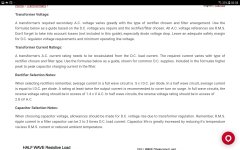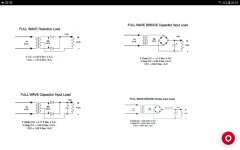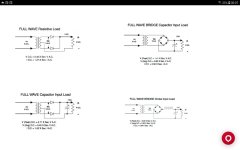1. What is the max bit rate/resolution that Gabster's build (PurePi + FifoPiQ7 + HdmiPi Pro + RPi4) supports for PCM and DSD playback?
It's capable of 768KHz, but RPi software limits to 384KHz so far
2. 2. If I want native DSD support all the way to DSD512, I reckon I need a BridgePi with Amanaro Combo384. Where do I insert this in Gabster's stack above? PurePi > RPi4 > BridgePi + Amanaro > FifoPi > HdmiPi Pro?
Please wait for my RecieverPi DDC unless you have USB input only.
3. Also the new SC-Pure clocks you are going to release, does it support only 384Khz max for PCM signals?
SC-Pure 45/49 support up to 384KHz
I would like to point out that if you use Gentoplayer on your Rasberry pi for a player software (also far better sounding than the others) you can select the kernel option to do DSD512 and up to PCM1536 via GPIO.
Gentoplayer is not free, but worth every penny. I use Gentoplayer with all his custom kernels and Diretta (also a purchase, but incredible). You use diretta asio driver on your pc/server and the diretta host is built into gentoplayer. This sounds FAR better than any other interface like UPNP interfaces.
I use my computer with Roon to HQplayer and use HQplayer to upsample to DSD512 and within HQplayer output is set to Diretta (after diretta asio driver is installed on your computer - within the driver settings you find / put the ip address of the rpi running the diretta host which is built into gentoplayer and the sound goes from pc/server to rpi and sounds INSANE.
Even with my rpi output via its usb to my DAC the sound is INCREDIBLE. I am waiting to build an ian canada streamer/dac, which I am doing soon. This combo tho with gentoplayer, hqplayer, and diretta beats my SMS-200 ultra with a BOTW linear power supply with additional ifi ipower
Does anyone know if there is an ifi ipower 5V/3A? I had to switch to a cheaper 3A supply for my RPi4 and I think I can hear a reduction in sound quality.
@WladimirMXP Thanks for sharing this. Am I correct in identifying this stack. Please fill two ??? cards which I am unable to track.No, of course I'm not running screens or any other peripherals on my Rpi. I have it for audio purposes (endpoint only), not multimedia and I'm a purist, so everything unnecessary is disabled on kernel level. Still and again, my RPi / Purepi tower doesn't consume more than 1.5A even during the start of the battery charging and one additional network switch to power.
View attachment 1210963
PurePi - RPi3 with schield tray grounded - shield pi pro - ??? - Fifi Q7 - ??? - TransportPi AES - Un Conditioner 3.3v
I am also having doubt how the clocking cable connected here (not seeing it from Q7 ) so please advise from - to.... Thanks,
Very clever using a stainless steel ashtray as a cage.and still pimped my toroidal transformer....with a stainless steel ashtray that I have flooded with epoxy, and previously lasered the lid 🙂 the cables are sheathed in cotton...
Just snapped up the last one on Amazon.ca thank you!
I can now power the irreverent screen until I graduate to purist user! I can always dedicate a pi to run the now playing screen to not impact the endpoint once I figure out what software I need. Right now I’m just trying to figure out everything that you guys do… and build a hifi streamer and separate DAC. Fun stuff.
I can now power the irreverent screen until I graduate to purist user! I can always dedicate a pi to run the now playing screen to not impact the endpoint once I figure out what software I need. Right now I’m just trying to figure out everything that you guys do… and build a hifi streamer and separate DAC. Fun stuff.
Hello friends,
wow didn't expect so many questions, I'll try to answer them.
The tower consists of:
PurePi
Rpi 3b (non-plus, just v1.2)
3mm copper cooling/shielding plate
Now onto Ians' boards:
ShieldPi Pro
Isolator II
FifoPiMa with Accus
Teradak shielding/filtering board
TransportPi AES
and obviously UcConditioner
DC cables are OCC copper/silver NEOTECH CU-AG-20-20 and now testing Mundorf Pure Silver/Gold 18AWG.
Plus there are some more important tweaks thorough and special care went to vibration isolation/absorption.
Also as @badd99 pointed out, Gentooplayer with Diretta is an important piece of it as well, especially when tweaked with kernel selection and other more tweaky tweaks 😆 Benefits of having Diretta is like instantly having the best LAN cable out there and btw Diretta is free for playing redbook format. Other than an endpoint like this (or any other Rpi), you just need to set up a second source PC or RPi, connect those two on your network or directly as an server ("host") & endpoint ("target") and play 😎
wow didn't expect so many questions, I'll try to answer them.
The tower consists of:
PurePi
Rpi 3b (non-plus, just v1.2)
3mm copper cooling/shielding plate
Now onto Ians' boards:
ShieldPi Pro
Isolator II
FifoPiMa with Accus
Teradak shielding/filtering board
TransportPi AES
and obviously UcConditioner
DC cables are OCC copper/silver NEOTECH CU-AG-20-20 and now testing Mundorf Pure Silver/Gold 18AWG.
Plus there are some more important tweaks thorough and special care went to vibration isolation/absorption.
Also as @badd99 pointed out, Gentooplayer with Diretta is an important piece of it as well, especially when tweaked with kernel selection and other more tweaky tweaks 😆 Benefits of having Diretta is like instantly having the best LAN cable out there and btw Diretta is free for playing redbook format. Other than an endpoint like this (or any other Rpi), you just need to set up a second source PC or RPi, connect those two on your network or directly as an server ("host") & endpoint ("target") and play 😎
Hello,No, of course I'm not running screens or any other peripherals on my Rpi. I have it for audio purposes (endpoint only), not multimedia and I'm a purist, so everything unnecessary is disabled on kernel level. Still and again, my RPi / Purepi tower doesn't consume more than 1.5A even during the start of the battery charging and one additional network switch to power.
View attachment 1210963
Purepi max current during first start up was close to 1,8A
After draining the ultracaps with 2A load the new recharging was at a lower current then 1,8A
Original lifepo4 board has a 5v 2A that is recommended for the raspberry.
If you don't wanna make your stuff like a Christmas tree 2A will be enough.
I use choke input . To many people using their supplies the wrong way if you take a look at the Hammond website
Attachments
hey @gerihifi , yes that role is for grounding, I also use a second modded one with silver fork for grounding my network via the bottom switch (Aqvox SE).@WladimirMXP ..purist here as well... like it..the wood-role is for grounding?
Especially your stacked D-Link switches I love (i personally use Paul Pang, as well an TeraDak with external linear PSU)...it makes a difference for me, for an "audiophile-grade DAC/Streamer" ;-)
As you said, switches unfortunately make a difference and not exactly a subtle one.. The more experiments I make, the more I find the importance of multiple reclocking of the music data along the way to the target. But there are some principles to follow in this delicate subject..
Disclaimer for others: I was a non-believer or sceptic at first, so don't attack me for my observation, if you find it impossible (as I did before).
So a laptop with ssd drive hosting the music and player diretta host could be connected straight to rpi based ian purist diretta target player?
I thought that it has to be connected to the home internet box for routing duties.
I thought only usb input dacs could work (Aka the diretta target could only output a usb signal and not a spdif on (transportpi AES for example)
Please correct me if I’ m wrong 👍
I thought that it has to be connected to the home internet box for routing duties.
I thought only usb input dacs could work (Aka the diretta target could only output a usb signal and not a spdif on (transportpi AES for example)
Please correct me if I’ m wrong 👍
Calling all purists!
What is the advantage of all the network protocols and to have the hifi gear just be “the endpoint” receiving music over some spaghetti networking protocols, dongles, noise filters and such to clean up network noise and re-clock the TCP/IP’s signals of re-clocked PCM and such?
The old school purists had the source directly connected to the gear playing it - tape, vinyl, Cassette , whatever - Connected to pre-amp and amp - no Network, best shortest cables and direct path.
What’s wrong with having Ian’s gear connected directly to the SSD source for lossless if it only costs 0.5 amps on the pi power source to hook a drive up? What’s wrong with that?
Instead of spending several hundred dollars trying to get network transmission perfect and clean? Source (FLAC or other lossless) directly connected to the stack playing it - like the old purist days? Shortest path argument ? Isn’t the shortest path the best? That’s what Ian’s hardware does. Shortest path to transmit an unaltered source to the destination.
Help me understand the better audio argument to have the source a mile away from the endpoint as far as audio fidelity?
What is the advantage of all the network protocols and to have the hifi gear just be “the endpoint” receiving music over some spaghetti networking protocols, dongles, noise filters and such to clean up network noise and re-clock the TCP/IP’s signals of re-clocked PCM and such?
The old school purists had the source directly connected to the gear playing it - tape, vinyl, Cassette , whatever - Connected to pre-amp and amp - no Network, best shortest cables and direct path.
What’s wrong with having Ian’s gear connected directly to the SSD source for lossless if it only costs 0.5 amps on the pi power source to hook a drive up? What’s wrong with that?
Instead of spending several hundred dollars trying to get network transmission perfect and clean? Source (FLAC or other lossless) directly connected to the stack playing it - like the old purist days? Shortest path argument ? Isn’t the shortest path the best? That’s what Ian’s hardware does. Shortest path to transmit an unaltered source to the destination.
Help me understand the better audio argument to have the source a mile away from the endpoint as far as audio fidelity?
@fusion360guy
The answer is that not everyone is a purist and everyone has their own definition of purity. Most people at this level are seeking a balance between convenience and sound quality. Anybody on this forum in general is not only a purist when compared to the vast majority of the population, but also an extremist!
In my setup, I have a RPI4 CM4 acting as a Diretta HOST that I can access via Wifi. This is feeding my Target player which is in a different enclosure. Both filled to the brim with Ian's hardware. There is only a single ethernet cable between the Host and Target and all audio comes from an M.2 SSD in my Host. There is no router or even switch between the boxes so it is as pure as it can get. Having said that, it takes a lot of tinkering and dialing things in and even when I want to add a new album it takes a long time to upload to the server. In short, it is very inconvenient. For me personally, it is worth it due to the sound quality alone. The trouble with this hobby is, once you've heard something at a certain level, it is difficult to go back.
If somehow I could have the same sound quality but streaming through Tidal or Qobuz or even through my local network, then I would do that in a heartbeat. It is much more convenient and you have an entire world of music at your fingertips. Unfortunately, there is always a compromise and each individual needs to decide for themselves how far they want to take this obsession. We are all already taking it 'too far' in the eyes of most people when we are eagerly awaiting releases from Ian for new hardware drops so we can geek out and build our systems! Now we are just talking not only about the Creme de la Creme, but the Creme de la Creme de la Creme. At some point is has to stop......or does it. <evil laughter>
The answer is that not everyone is a purist and everyone has their own definition of purity. Most people at this level are seeking a balance between convenience and sound quality. Anybody on this forum in general is not only a purist when compared to the vast majority of the population, but also an extremist!
In my setup, I have a RPI4 CM4 acting as a Diretta HOST that I can access via Wifi. This is feeding my Target player which is in a different enclosure. Both filled to the brim with Ian's hardware. There is only a single ethernet cable between the Host and Target and all audio comes from an M.2 SSD in my Host. There is no router or even switch between the boxes so it is as pure as it can get. Having said that, it takes a lot of tinkering and dialing things in and even when I want to add a new album it takes a long time to upload to the server. In short, it is very inconvenient. For me personally, it is worth it due to the sound quality alone. The trouble with this hobby is, once you've heard something at a certain level, it is difficult to go back.
If somehow I could have the same sound quality but streaming through Tidal or Qobuz or even through my local network, then I would do that in a heartbeat. It is much more convenient and you have an entire world of music at your fingertips. Unfortunately, there is always a compromise and each individual needs to decide for themselves how far they want to take this obsession. We are all already taking it 'too far' in the eyes of most people when we are eagerly awaiting releases from Ian for new hardware drops so we can geek out and build our systems! Now we are just talking not only about the Creme de la Creme, but the Creme de la Creme de la Creme. At some point is has to stop......or does it. <evil laughter>
@WuBai
Thank you. This is a great answer that helps me understand there is another level I haven’t heard yet. You are correct in saying once you hear such pure sound like you have never heard you can’t go back.
For me it’s my current streamer stack. I’m building an Ian DAC stack to replace my DacMagic200M and will connect with i2S. I will see if that brings another level of clarity to what I thought now was sounding amazing.
I think I’ll have both running together by next week.
Here we come extremist purist level tinkerer 😂
Thank you. This is a great answer that helps me understand there is another level I haven’t heard yet. You are correct in saying once you hear such pure sound like you have never heard you can’t go back.
For me it’s my current streamer stack. I’m building an Ian DAC stack to replace my DacMagic200M and will connect with i2S. I will see if that brings another level of clarity to what I thought now was sounding amazing.
I think I’ll have both running together by next week.
Here we come extremist purist level tinkerer 😂
Hello,
I made a string of 0,22 ohm 7 watt resistors so i could easily compose a load like 2 or 2,5 A . A 2,5A supply was recommended for the purepi. So i did some test to make the LCRC supply that feeds Doede's 5 volt supply.
After some test i connected the purepi and measured the max current was only 1,8A so i " redesigned " the supply for 2A
Of course most cheap 2,5 A supplies available on the cheap part of internet where most of us will buy their stuff were not actually designed to deliver 2,5A all the time for a decade so Ian used a safety margin.
Greetings,Eduard

I made a string of 0,22 ohm 7 watt resistors so i could easily compose a load like 2 or 2,5 A . A 2,5A supply was recommended for the purepi. So i did some test to make the LCRC supply that feeds Doede's 5 volt supply.
After some test i connected the purepi and measured the max current was only 1,8A so i " redesigned " the supply for 2A
Of course most cheap 2,5 A supplies available on the cheap part of internet where most of us will buy their stuff were not actually designed to deliver 2,5A all the time for a decade so Ian used a safety margin.
Greetings,Eduard
I have the LinearPiMkII Duo no less - now powered by 2 12VDC power adapters!

This will power my OPA861 I/V board on the Ian DAC stack I’m making. I’m getting the required 5V out the other side like I should.
All that gear just to clean power that little tiny analog board for the XLR outputs!
Super excited.
Stay tuned for the stack build.
This will power my OPA861 I/V board on the Ian DAC stack I’m making. I’m getting the required 5V out the other side like I should.
All that gear just to clean power that little tiny analog board for the XLR outputs!
Super excited.
Stay tuned for the stack build.
Same here,i´m a purist.Go for short path.Calling all purists!
What is the advantage of all the network protocols and to have the hifi gear just be “the endpoint” receiving music over some spaghetti networking protocols, dongles, noise filters and such to clean up network noise and re-clock the TCP/IP’s signals of re-clocked PCM and such?
The old school purists had the source directly connected to the gear playing it - tape, vinyl, Cassette , whatever - Connected to pre-amp and amp - no Network, best shortest cables and direct path.
What’s wrong with having Ian’s gear connected directly to the SSD source for lossless if it only costs 0.5 amps on the pi power source to hook a drive up? What’s wrong with that?
Instead of spending several hundred dollars trying to get network transmission perfect and clean? Source (FLAC or other lossless) directly connected to the stack playing it - like the old purist days? Shortest path argument ? Isn’t the shortest path the best? That’s what Ian’s hardware does. Shortest path to transmit an unaltered source to the destination.
Help me understand the better audio argument to have the source a mile away from the endpoint as far as audio fidelity?
Hello ,
Short paths is a good starting point. For my power supply test set up i used a bit longer wires because i wanted to be able to turn the circuit board upside down.
The connections between transformer, rectifier, input choke and first cap need to be short. You always read that is where the work is done and done continuously because 2A drains your supply really quickly.
You can read in the Hammond document with a cap input current being drawn is far from steady.
I think in my set up it will be the best to put Doede's circuitboard a few inches from the purepi. I soldered the dc input wires directly onto the board using Kimber cable.
Still have to design something to mount the complete stack in a suspended way on the chassis. If there are sturdy cables being connected from every direction a few spikes won't do much.
If you scratch one of these hoses and put your stethoscope on the clock you should not hear anything.
Food for thought!
Greetings,Eduard
Short paths is a good starting point. For my power supply test set up i used a bit longer wires because i wanted to be able to turn the circuit board upside down.
The connections between transformer, rectifier, input choke and first cap need to be short. You always read that is where the work is done and done continuously because 2A drains your supply really quickly.
You can read in the Hammond document with a cap input current being drawn is far from steady.
I think in my set up it will be the best to put Doede's circuitboard a few inches from the purepi. I soldered the dc input wires directly onto the board using Kimber cable.
Still have to design something to mount the complete stack in a suspended way on the chassis. If there are sturdy cables being connected from every direction a few spikes won't do much.
If you scratch one of these hoses and put your stethoscope on the clock you should not hear anything.
Food for thought!
Greetings,Eduard
Attachments
- Home
- Source & Line
- Digital Line Level
- Asynchronous I2S FIFO project, an ultimate weapon to fight the jitter




